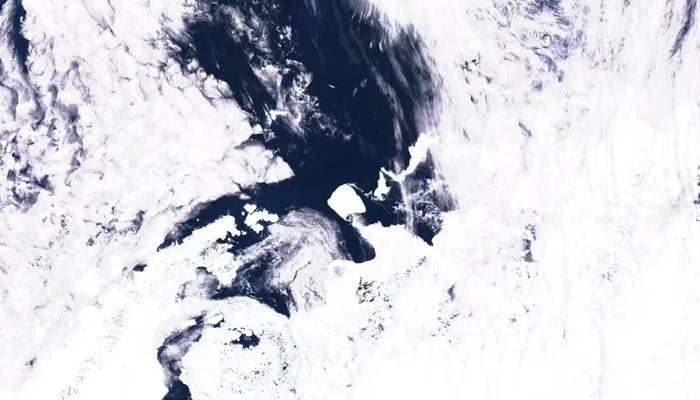A23a The Antarctic Behemoth Sets Sail – World’s Largest Iceberg Breaks Free After Three Decades
In a remarkable turn of events, the colossal Antarctic iceberg, A23a, has broken free from its three-decade-long entrapment and is now on a journey through the Southern Ocean. The magnitude of this icy giant is unprecedented, measuring almost 4,000 square kilometers, roughly three times the size of New York City. Initially calving off West Antarctica’s Filchner-Ronne Ice Shelf in 1986, A23a has been a dormant behemoth, hosting a Soviet research station until its base became stuck on the Weddell Sea floor. Recent satellite images depict a swift drift past the northern tip of the Antarctic Peninsula, propelled by strong winds and currents, leaving scientists intrigued and watchful.

The Journey Begins:
For the first time in over three decades, A23a is making its way into uncharted territory. Scientists, led by British Antarctic Survey glaciologist Oliver Marsh, are closely monitoring this unprecedented movement of an iceberg of such colossal proportions. The iceberg, weighing nearly a trillion metric tones, is gaining momentum as it moves toward the Antarctic Circumpolar Current, known as “iceberg alley,” where similar giants float ominously in the dark waters.
The Science Behind the Drift:
The reason behind A23a’s sudden departure from its stationary position is still a subject of scientific inquiry. Marsh speculates that over time, the iceberg may have thinned slightly, gaining the extra buoyancy needed to lift off the ocean floor and succumb to the push of ocean currents. Additionally, A23a is one of the world’s oldest icebergs, and its longevity could be contributing to this newfound mobility.
Potential Impact on Wildlife:
As A23a continues its journey, scientists are considering the potential impact on South Georgia island, a crucial breeding ground for millions of seals, penguins, and seabirds. If the iceberg were to become grounded again, it could obstruct access for the island’s wildlife, echoing concerns raised by the 2020 incident involving iceberg A68. A collaborative effort managed to avert a catastrophe when A68 broke into smaller fragments before colliding with South Georgia. However, the threat remains as A23a ventures into the Southern Ocean, with the possibility of disrupting shipping routes as it approaches South Africa.
The Uncertain Future:
The fate of A23a remains uncertain, with possibilities ranging from it becoming grounded again to breaking into smaller fragments like its predecessor, A68. Marsh suggests that an iceberg of this magnitude could survive for an extended period in the Southern Ocean, even in warmer waters. The potential for it to make its way toward South Africa, disrupting shipping routes, adds a layer of complexity to the ongoing scientific observation.

Conclusion:
As A23a, the world’s largest iceberg, embarks on its unexpected journey through the Southern Ocean, scientists are left grappling with questions about its sudden mobility and potential impact on the surrounding ecosystem. The colossal iceberg, with its almost mythical presence, serves as a stark reminder of the dynamic nature of Antarctica’s icy landscapes and the interconnectedness of its delicate ecosystems. Only time will unveil the true course of A23a’s journey and the impacts it may leave in its icy wake.

![Ashraf Amra/Anadolu Agency]](https://trendingcon.com/wp-content/uploads/2023/11/AA-20231129-33060324-33060322-HAMAS_HANDS_OVER_ISRAELI_PRISONERS_TO_RED_CROSS_OFFICIALS-1701322436-390x205.webp)
